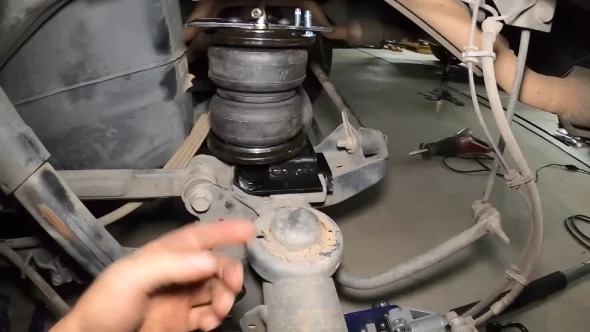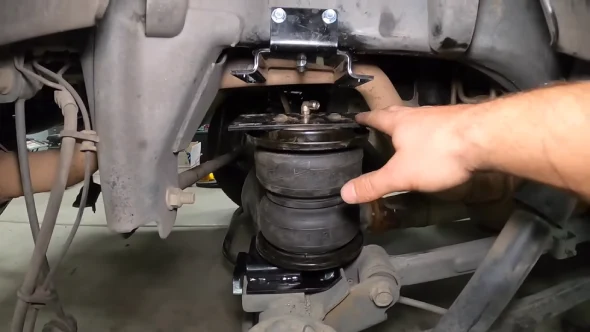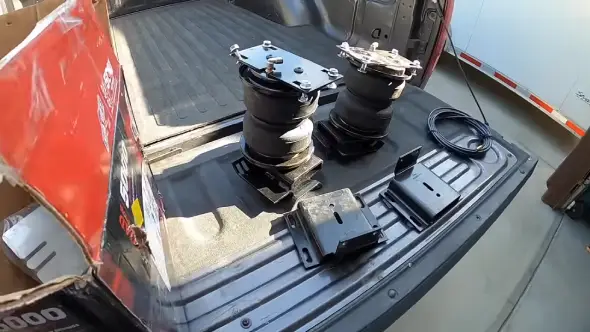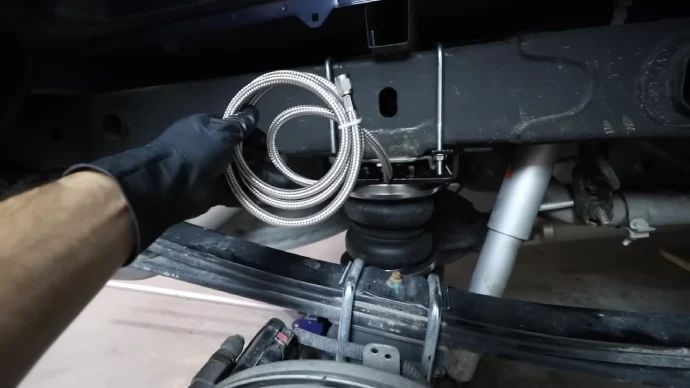Last Updated on April 19, 2023
Air suspension systems have grown in popularity recently, and they offer several benefits when used to lift a truck or SUV. They provide higher levels of stability and comfort on roads and in extreme off-road conditions, allowing for superior performance, better control, and greater traction.
The installation cost may be relatively high, yet the overall improvements in ride quality make it an appealing choice for anyone looking to lift their vehicle. Air suspension systems are possible to install even for non-professionals with basic knowledge and the right tools.
So if you want increased safety and superior ride comfort at the same time when lifting your truck or SUV, then air suspension is definitely worth considering. Here, we provide comprehensive step-by-step instructions on safely lifting your truck while taking advantage of it having air suspension.
How Can You Lift A Truck With Air Suspension: Simple Steps

Lifting a truck using air suspension is an easy and cost-effective way to get the look and performance you desire. It involves installing a coil over kit, dummy chipping the truck’s computer, and adjusting the shocks for maximum performance and comfort.
Safety Precautions
Before beginning any installation project, it’s important to take safety precautions. Ensure you are familiar with the tools required for the job and use proper safety equipment, such as gloves, eye protection, and a dust mask. Familiarize yourself with the parts before starting work, and disconnect the battery before beginning any electrical work.
Step 1: Gathering Necessary Materials
The first step in installing an air suspension lift kit is gathering the necessary materials. You will need a coil over kit (6″ recommended) and tires (37″ recommended). Depending on your vehicle’s make and model, you may also require additional components like shocks or struts.
Ensure to purchase all components from a trusted source to ensure quality and compatibility with your specific model of truck.
Step 2: Preparing Your Vehicle
After gathering all the necessary components, you should begin preparing your vehicle by removing its existing air suspension components. Be sure to carefully follow all instructions provided with the parts so that nothing is damaged during removal.
If applicable, you should dummy chip your truck’s computer in order to prepare it for installation of the new lift kit.
Step 3: Installing Coil Over Kit
Once the existing components have been removed from the vehicle, it’s time to install the coil-over kit in their place. Begin by securely fastening each shock into place using appropriate hardware for maximum stability and safety during use.
Afterward, connect all necessary wiring and ensure that everything is working properly prior to testing out the truck suspension system.
Step 4: Testing Suspension System
To ensure everything has been installed correctly, test out the new lifted truck suspension system on a flat surface before taking the truck out for a drive or off-roading adventure. Adjust any final settings needed for comfort or performance until you are satisfied with its performance capabilities.
Once complete, enjoy driving around town or conquering tougher terrain, knowing that your truck is lifted safely.
Advantages of Installing Air Suspension for Lifting a Truck

Air suspension systems have become increasingly popular technology when it comes to lifting trucks. This type of suspension system offers a wide range of benefits, from enhanced stability and improved traction to increased ride comfort.
It is the ideal system for those looking for an efficient and reliable way to lift their truck.
1: Enhanced Stability
Air ride suspension systems offer increased stability when lifting trucks due to their air-filled chambers. The air-filled chambers are able to absorb shocks more effectively than traditional suspension systems, which reduces the risk of damage caused by uneven road surfaces or off-road terrain.
The air-filled chambers provide more dynamic support on a variety of surfaces, meaning that even if the truck is loaded with heavy cargo, its stability remains unaffected.
2: Increased Ride Comfort
Air suspensions also provide a much smoother ride quality compared to other types of suspension systems. As previously mentioned, air-filled chambers absorb shocks and vibrations more effectively than traditional springs or dampers.
It results in a smoother journey over rough terrain or uneven ground conditions. Air suspensions can also be adjusted quickly and easily according to load weight and driver preference, further increasing overall ride comfort levels.
3: Improved Traction and Control
In addition to providing greater stability and ride comfort when lifting trucks, air suspensions also improve traction control for improved handling capabilities on both wet or dry surfaces alike. Air-filled chambers allow for precise adjustment over the amount of grip available at any given time.
This allows drivers to be confident in their ability to keep the vehicle secure even during difficult driving conditions such as rain or snow. These systems allow for fine tuning of the entire vehicle’s handling so that it performs optimally in all circumstances regardless of surface conditions.
What Are The Disadvantages of Air Suspension When Lifting A Truck?

Air suspensions can be a great option for lifting your truck but may not always offer the desired results. Mechanical issues often arise that could reduce payload capacity and require costly installation and maintenance fees, so make sure you weigh all of your options before deciding on air bag suspension.
1. Prone to Mechanical Issues:
Air suspensions are more prone to mechanical issues compared to traditional spring systems. These issues can range from leaks in hoses and seals that require frequent repairs or replacements to problems related to alignment or other components.
These problems require expertise beyond basic mechanics skills to repair properly. Furthermore, these issues tend to become more common over time as wear-and-tear accumulates on the system’s components, leading to additional repair costs over time.
2. Reduced Payload Capacity
Air suspension with lifting a truck reduces the vehicle’s payload capacity, which is the weight that can safely be carried in the bed or on a trailer attached to the vehicle.
Due to its complexity, an air-based system adds additional weight, reducing this capacity by about 10%. This means less cargo can safely be carried when an air-based system is used to lift a truck.
3. High Initial Cost of Installation:
The installation cost for air suspension can be very high, especially if you buy specialized parts from aftermarket stores.
Specialized tools such as compressors and special alignment systems may be required to keep the suspension running at peak performance. It further increases the overall cost of using an air suspension system.
4. Increased Risk of Rollovers
Rollover crashes are some of the most dangerous types of motor vehicle accidents because they often result in devastating injuries for drivers or passengers inside the car at the time of impact.
Improperly installed airbag kits with lift kit suspension systems may increase a vehicle’s center of gravity, which makes them more likely to tip over during high-speed turns or sudden maneuvers at high speed, like swerving around an obstacle in traffic.
Also, some vehicles, such as SUVs, are simply more susceptible to rollovers even without modifications due to their height, making them top-heavy compared to other cars on the road. Drivers should exercise caution while driving these vehicles by avoiding sharp turns and rapid changes in direction.
Is it Safe to Use Airbags Suspension Lift With a Pre-Installed Lift Kit on My Vehicle?

When installed correctly, airbag suspension lift kits are generally safe to use with an already installed lift kit. But some vehicles may not be compatible with pre-installed lift kits. This is because the existing suspension components of the vehicle may not be able to handle the additional weight or strain caused by adding an airbag system.
It is also possible for a pre installed lift kit to damage the airbag system if it utilizes stiffer springs. For safety reasons, consult a mechanic before installing an airbag suspension kit with a preassembled lift kit.
They can assess whether the existing suspension components of your vehicle are suitable for use with an airbag system and make any necessary adjustments or replacements if required. Also, they can advise on tuning your existing setup to work harmoniously with any added components.
How High Can Airbags Suspension Lift Raise a Car With a Lift Kit?
Airbag suspensions are designed to provide adjustable height for vehicles and are commonly used in combination with aftermarket lift kits. When using an airbag suspension lift, cars can typically be raised up to 4 or 5 inches from the original ride height.
Higher lifts may be achievable depending on the type of airbag setup and other components used, such as springs and struts. The ultimate goal is optimal ride quality while providing enough space to fit larger tires or wheels.
If done correctly, an airbag suspension system can improve your car’s look and feel while allowing you to customize it simultaneously.
Can You Get a Lift Kit with Air Suspension?

Enhance your ride with a leveling kit equipped with air suspension. Custom-engineered control arms, spindles, and 4-links give you the power to add height, while extended trailing arms, track bar links, taller air bag, and brackets mean that fully supporting those higher levels is no longer an issue.
So if you want superior automotive performance, find the most suitable solution in our post about the best air lift suspension. Ensure the selected air lift suspension system has a durable construction, high-quality components, and features that adapt to your driving style.
Can You Daily Car with Air Suspension?
Air Suspensions can bring a smooth, comfortable ride to cars driven daily. Maintained correctly by certified mechanics or technicians and adjusted for everyday road conditions, air suspensions provide an ideal balance between improved driving experience and reliable performance.
Can You Lift a Ram Truck with Air Suspension?
Using air suspension, you can take your Ram truck to new heights. With adjustable shocks and struts mounted on the vehicle, you’ll be able to adjust its ride height far beyond factory settings. Explore just how much lift is possible with a combination of components that best suits your needs!
But it is typically enough to give your truck sufficient ground clearance for recreational activities such as off-roading.
Can You Drive Fast with Air Suspension?
Air suspensions provide a safe and reliable driving experience even when going fast. Their ability to absorb road bumps means you can stay in control, while their improved handling characteristics give better freedom of expression on the roads.
Although not suited for extreme motorsport events, air suspension setups are sufficient enough when traveling at average speeds, enabling smoother rides with greater stability than ever before.
Is Air Suspension Worth It for Towing?

Taking the stress out of towing, air suspension systems provide a host of benefits that make it an invaluable investment. From adjusting ride height and stabilizing loads to absorbing shocks and vibrations, these suspensions reduce sagging while improving braking performance.
It ensures greater safety during your journeys as well as increased comfort for you & your passengers.
How Long Does Air Lift Suspension Last?
Durable and built with quality components, they can last between 50K to 100K miles with routine upkeep. Some have even clocked in more than that. Don’t be intimidated by maintenance, either. Investing time in preventative care pays off when you find yourself riding smoothly for years down the road.
Unlock Optimal Performance with Air Suspension for Your Truck
Air suspension can be an excellent way to increase your truck’s stability and comfort while providing improved traction and control when traversing rough terrain. It comes with its own disadvantages, such as a high initial cost and reduced payload capacity.
Weighing up all of the pros and cons carefully is essential before lifting your truck with air suspension. If you do decide to go ahead with this option, ensuring that you understand how to properly lift the vehicle is key to achieving maximum air lift performance from your suspension system.
